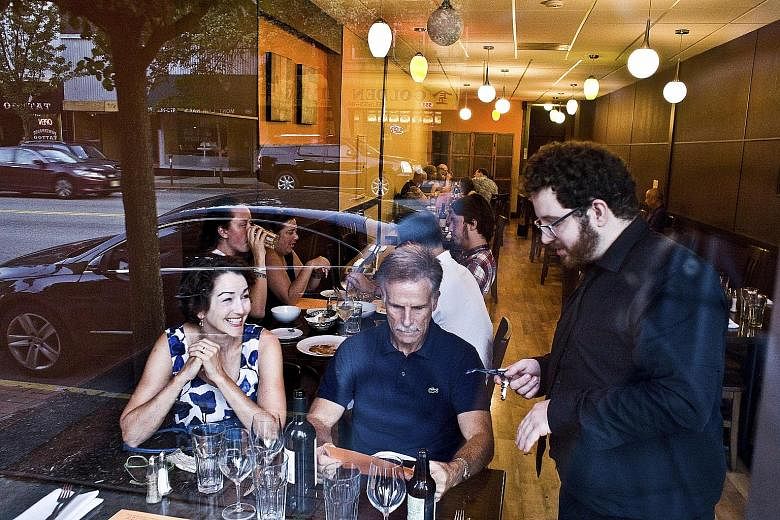NEW YORK • How often have you bought something you felt was not worth the money?
What if you could set the price?
What factors would influence your number?
For years, behavioural scientists have studied such questions.
They often look at a model called PWYW (Pay-what-you-want). The idea may seem like a consumer's giddiest fantasy. But a real-life extreme version of the experiment unfolding at a restaurant in Montclair, New Jersey, is affirming the researchers' predictions. It has been triggering a panoply of reactions - including anxiety, delight, incredulity, guilt and, yes, rampant opportunism.
Mr Zod Arifai, a local chef, is offering customers a menu with no prices for the month of August, encouraging them to order as many dishes as they would like at his two side-by-side restaurants. When diners signal for the check, servers ask, "How much would you like to pay?" With no price guidelines - such as a museum's "suggested donation" - the offer compels diners to gaze inward and develop ad hoc criteria, in order to look a fresh-faced server in the eye and announce the meal's value.
Dr Ayelet Gneezy, an associate professor of behavioural sciences and marketing at the University of California, San Diego, who has studied this model, said it could set off psychological conflict: Consumers like to see themselves as "fair" and even generous, but also want others to see them as "prudent and not a sucker".
"I know I'm going to overpay," Mr Morgan Torres said the other night as he perused the menu. "I don't want them to think of me as 'that cheap guy at table five.' "
When chef Arifai, 52, opened his first restaurant, Blu, in Montclair, a diverse suburb of New York City, a decade ago, The New York Times rated it "excellent". Then, he opened the more casual and also warmly praised Next Door, next door. Blu's skate with cauliflower, wild mushrooms and truffle broth used to be US$26 (S$36); Next Door's meatloaf with chipotle glaze on soft polenta was US$14.
With his lease ending, he has decided to move on, and eventually open a restaurant in Manhattan.
A former rock guitarist with ungovernable hair, he wanted to thank the community with a month of pay-what-you-want dining - despite the entreaties of family and friends who pronounced the concept "insane".
In the spirit of equality, he is serving the same menu at both restaurants. But at upscale Blu, with its sleek stemware and soft sconce lighting, diners are paying about US$3 more a dish than those at Next Door, with its bright, basic decor.
Overall, chef Arifai said, diners seem to be paying slightly less than half the old menu prices, though a direct comparison is difficult because these portions are somewhat smaller.
"The majority of people want to take advantage of the offer, but also recognise that it feels weird," said Dr Kathleen D. Vohs, a professor of marketing at the University of Minnesota who writes about the psychology of money. "So they limit what they order, do a good job of valuing it and then walk back from what it's worth."
At least once a night, the staff gets a bad taste - such as from the "young, smug" table of five that ordered 25 dishes, paid US$15 and left a US$5 tip.
But another family left a thank-you note with their modest amount. "The food and service was worth way more than we were able to leave," it read. "As a kid in college and a mother doing inconsistent freelance, without the deal we wouldn't have gotten the chance to come."
Dr Vohs said what might compensate for the low-ballers are the angst-ridden outliers squirming at the other end of the bell curve "who feel they have to make up for what they see as others' misdeeds".
The other night Ms Lesley Jarbe was in a swivet as she anticipated that post-dessert moment of truth. She had heard stories about the shortchangers.
"I want to show the chef that I love his food and I appreciate what he's doing," she said. "And I worry about the kitchen staff! The waiters! I'm so anxious!"
And then there was the customer who somehow manned both ends of the bell curve: He took advantage of chef Arifai's generosity, even as he expressed concern about the server's pending unemployment. The solution? He left US$5 for the food and a US$50 tip.
Profit aside - and it certainly will be - chef Arifai considers the endeavour a success.
"I've learnt that humanity is not as bad as we think," he said. Yes, 20 per cent are paying less than a dollar a dish. "But 80 per cent are not."
NEW YORK TIMES

